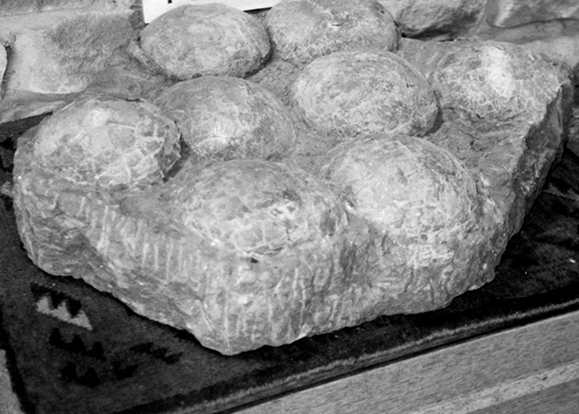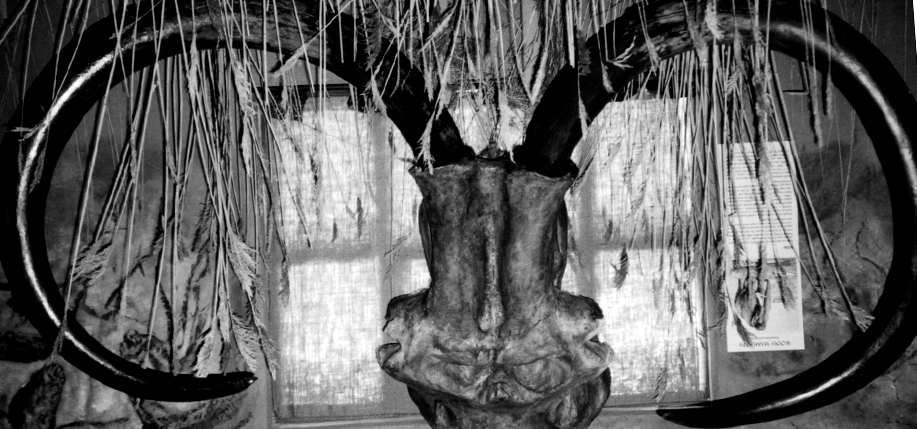How many men can say they live with four women and the only woolly mammoth in Ireland?
Harris Moore can, because his home in Ventry on the western Dingle Peninsula is also the unique Prehistoric Celtic Museum, whose feature attraction is “Millie,” a 300,000-year-old woolly mammoth.
Moore, 41, divides his time between his chores as the museum’s owner/curator/ docent/manager/ticket-taker/janitor, and family duties as a husband and father to toddler Anu, and two girls from a previous marriage.
(Anu is the name of the first earth goddess in pre-Celtic Ireland; legend has it that the inhabitants of that era were called the Tuatha De Danann, meaning “the tribe of Anu.” Today, near Killarney, there are two breast-shaped mountains called “The Paps of Anu.”)
The museum, one of the most fascinating stops a tourist can make when visiting the charming and musically booming town of Dingle, is the realization of a lifelong dream. Barely out of his toddler years, Moore began coaxing his parents to take him to the Museum of Natural History in New York City. At the age of six, Moore dug up an old bottle in the back yard of his Westport, Connecticut home. After that, he methodically excavated a good portion of the town looking for antique bottles, fossils, and other treasures.
The attraction to antiquities stayed with him. Moore earned a degree in Cultural Anthropology from the University of California at Santa Cruz, and while doing so, he learned to play the hammered dulcimer during a “Celtic Revival” festival.
The day he graduated, he flew to Europe with his girlfriend, and for eighteen years he traveled throughout western Europe, playing on street comers and at parties.
To date, Moore has recorded two best-selling CDs with his group, Northern Lights, and is currently finishing up a solo album.
While living in Copenhagen Moore took an interest in the Neolithic traditions of the Danes, who in ancient times had lots of flint but the bad fortune of having no copper. Thus, while southern Europe hammered its way into the Bronze Age, the Danes kept up with the fashion by copying bronze tools and weapons in their native flint, the result being the most sophisticated and fragile, hence useless, stone masterpieces of the age.
Moore tracked down an old man on a small Danish island who was selling his collection of flint artifacts. From then on it was simply a matter of accumulation by attrition.
“I’d sell everything I didn’t absolutely adore,” Moore says, “and use the profits to buy another collection. Then I studied the Bronze Age, did more buying and selling, and finally discovered the Celts.”
And the rest is, well, history. Moore eventually took a job as a consultant to various antique dealers, and while on a 1991 “busking” holiday in Dingle fell in love with the locale. On his return three years later, he was impressed that everyone remembered him, and in 1998, he returned for good.
“I particularly liked the natural beauty of this area, as well as the music scene and the wealth of local archeological sites,” he says. “It also didn’t hurt that I was among English-speaking people with a flair for conversation and a great sense of humor.”
Dingle is indeed noted for its abundant musical offerings, from classical Irish and folk to jazz and calypso. On any given night the popular routine is to simply walk the streets and when the music that appeals to you emanates from a particular pub, that’s the one you go in.
Today, the casual traveler in West Kerry is pleasantly surprised by Moore’s totally captivating Prehistoric Celtic Museum, situated in an unpretentious roadside pullout miles above Dingle Bay on the Slea Head Road.
For starters, when entering the museum you’ll walk across a stone floor whose intricate pattern was etched by sea worms 300 million years ago.
Beyond, the visitor then examines hundreds of rare and ancient artifacts. Covering two floors, the displays include 70-million-year-old dinosaur eggs from China; Scandinavian amber jewelry from 6000 B.C.; flint axes used to clear the primeval forests of Europe 6,000 years ago; prehistoric swords, daggers, spears, and even ice skates made of bone!
Unlike conventional museums, this one allows visitors to handle some artifacts, such as a 300,000-year-old hand-ax made by Homo Erectus. The fact that the family, mammoth included, all live under one roof only adds to the casual feel and charm of Moore’s place.

All the while, Millie enjoys being the focal point of this exceptional museum. (“Millie” is Moore’s pet name for the one-of-a-kind artifact, although paleontologists have confirmed that, in fact, “she” is a “he.”) Millie was discovered in May 1999 in the nets of a small fishing trawler off the coast of Holland, at a spot that used to be the delta of a huge freshwater lake that was the source of the Rhine, Seine, Maas, and Thames rivers. Old animal bones are frequently found in the area, because in ancient times the entire North Sea and Irish Channel was a landmass, due to the world’s water supply being locked up by Ice Age glaciers.
After emerging from the water in 27 pieces, Millie was subsequently restored in central Holland by a father-son team specializing in Ice Age mammals. They were old buddies of Moore’s who happened to owe him a favor, so he was able to persuade them to sell it to him at an affordable price.
Millie was delivered to Ventry by the restorer and his family in a van from their home in Holland. It took two days and two ferries to get there. Millie’s cranium is shot full of plastic foam inside to make it solid. The whole skull and tusks have been immersed in various chemical baths (secret recipe) to preserve it. “We barely could get the main section of the skull through the front door,” says Moore, who is now actively trying to purchase a Triceratops skull from Texas (benefactors appreciated).
“First I have to pay off my start-up debts,” Moore notes, “and then I’d like to acquire a big dinosaur skull to match our set of dino eggs. I’d also like to set up an entire room for more Ice Age mammals, like a woolly rhino, bison, and Giant Irish Deer.” ♦


How are you.
Remembere from Amherst MA?
ELANE PETERSON
BRINCKERHOFF
Sad news Elaine. Harris passed away in September 2021. May he rest in God’s peace now.
This is indeed sad news. I had the good fortune to meet Harris in 2010. He made my trip memorable for a number of reasons I cannot say here. But I still carry today the ancient coins I acquired from him. A lovely man. Thankyou for the memories.